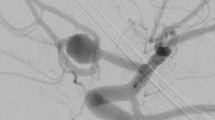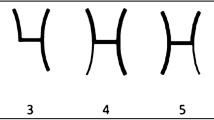Abstract
Background
Fenestrations of intracranial arteries are variants resulting from incomplete fusion of vessels during development with unknown clinical significance. They are best visualised with 3D rotational angiography (3DRA).
Objective
In a prospective consecutive series of patients with suspected aneurysms, 3DRA was performed to identify not only the potential bleeding source but also to assess the frequency and location of any fenestrations of intracranial arteries.
Methods
In 287 consecutive patients with possible intracranial aneurysms (accidental discovery or previous history of SAH), 3DRAs were prospectively performed, and the location of subarachnoid haemorrhage was assessed by CT.
Results
Of 174 patients presenting with SAH, 153 had saccular aneurysms, and in 21 cases (12.1 %), no source of bleeding was found. In 20 of these 21 patients with "unexplained SAH" (95.2 %) an arterial fenestration was detected in the neighbourhood of the clot. The incidence of fenestration in the 153 aneurysmal SAH patients was 22.9 %, and it was 23.3 % in 266 patients with intracranial aneurysms (113 accidental and 153 ruptured).
Conclusions
Arterial fenestration was detected in 22.9 % of ruptured cerebral aneurysms, in contrast with 95.2 % in patients with unexplained SAH, the difference being statisctically significant (p < 0.01). Fenestration is a developmental defect, a structural wall weakness possibly making the vessel prone to rupture. Its incidence of nearly 100 % may suggest a connection with idiopathic SAH. The presented data indicate that arterial fenestrations are generally overlooked, and they can be considered as one of the candidates for the source of idiopathic SAH.




Similar content being viewed by others
References
van Rooij SB, van Rooij WJ, Sluzewski M, Sprengers ME (2009) Fenestrations of intracranial arteries detected with 3D rotational angiography. AJNR Am J Neuroradiol 30:1347–1350
Gomes FB, Dujovny M, Umansky F, Berman SK, Diaz FG, Ausman JI, Mirchandani HG, Ray WJ, Mirchandani HG, Ray WJ (1986) Microanatomy of the anterior cerebral artery. Surg Neurol 26:129–141
Sanders WP, Sorek PA, Mehta BA (1993) Fenestration of intracranial arteries with special attention to associated aneurysms and other anomalies. AJNR Am J Neuroradiol 14:675–680
Serizawa T, Saeki N, Yamaura A (1997) Microsurgical anatomy and clinical significance of the anterior communicating artery and its perforating branches. Neurosurgery 40:1211–1216
de Gast AN, van Rooij WJ, Sluzewski M (2008) Fenestrations of the anterior communicating artery: incidence on 3D angiography and relationship to aneurysms. AJNR Am J Neuroradiol 29:296–298
Bayrak AH, Senturk S, Akay HO, Ozmen CA, Bukte Y, Nazaroglu H (2011) The frequency of intracranial arterial fenestrations: a study with 64-detector CT-angiography. Eur J Radiol 77:392–396
Bharatha A, Aviv RI, White J, Fox AJ, Symons SP (2008) Intracranial arterial fenestrations: frequency on CT angiography and association with other vascular lesions. Surg Radiol Anat 30:397–401
Andaluz N, Zuccarello M (2008) Yield of further diagnostic work-up of cryptogenic subarachnoid hemorrhage based on bleeding patterns on computed tomographic scans. Neurosurgery 62:1040–1046
Greebe P, Rinkel GJ (2007) Life expectancy after perimesencephalic subarachnoid hemorrhage. Stroke 38:1222–1224
Ildan F, Tuna M, Erman T, Gocer AI, Cetinalp E (2002) Prognosis and prognostic factors in nonaneurysmal perimesencephalic hemorrhage: A follow-up study in 29 patients. Surg Neurol 57:160–165
Rinkel GJ, van Gijn J, Wijdicks EF (1993) Subarachnoid hemorrhage without detectable aneurysm. A review of the causes. Stroke 24:1403–1409
Sarabia R, Lagares A, Fernandez-Alen JA, Arikan F, Vilalta J, Ibáñez J, Maillo A, Gabarros A, Domínguez J, Horcajadas A, Ballenilla F, Rodríguez-Boto G, Llacer JL, Arrese I, de la Lama A, Santamarta D, Delgado P, Muñoz MF (2010) Idiopathic subarachnoid hemorrhage: a multicentre series of 220 patients. Neurocirugia (Astur) 21:441–451
Matsumaru Y, Yanaka K, Muroi A, Sato H, Kamezaki T, Nose T (2003) Significance of a small bulge on the basilar artery in patients with perimesencephalic nonaneurysmal subarachnoid hemorrhage. Report of two cases. J Neurosurg 98:426–429
Schievink WI, Wijdicks EF (2000) Origin of pretruncal nonaneurysmal subarachnoid hemorrhage: ruptured vein, perforating artery, or intramural hematoma? Mayo Clin Proc 75:1169–1173
Sheehan JM, Cloft H, Kassell NF (2000) Symptomatic delayed arterial spasm following non-aneurysmal perimesencephalic subarachnoid hemorrhage: a case report and review of the literature. Acta Neurochir (Wien) 142:709–712
Song JH, Yeon JY, Kim KH, Jeon P, Kim JS, Hong SC (2010) Angiographic analysis of venous drainage and a variant basal vein of Rosenthal in spontaneous idiopathic subarachnoid hemorrhage. J Clin Neurosci 17:1386–1390
van Gijn J, van Dongen KJ, Vermeulen M, Hijdra A (1985) Perimesencephalic hemorrhage: a nonaneurysmal and benign form of subarachnoid hemorrhage. Neurology 35:493–497
Bradac GB, Bergui M, Ferrio MF, Fontanella M, Stura G (1997) False-negative angiograms in subarachnoid haemorrhage due to intracranial aneurysms. Neuroradiology 39:772–776
Hashimoto H, Iida J, Hironaka Y, Okada M, Sakaki T (2000) Use of spiral computerized tomography angiography in patients with subarachnoid hemorrhage in whom subtraction angiography did not reveal cerebral aneurysms. J Neurosurg 92:278–283
Inamasu J, Nakamura Y, Saito R, Horiguchi T, Kuroshima Y, Mayanagi K, Orii M, Ichikizaki K (2003) “Occult” ruptured cerebral aneurysms revealed by repeat angiography: result from a large retrospective study. Clin Neurol Neurosurg 106:33–37
Rinkel GJ, Wijdicks EF, Hasan D, Kienstra GE, Franke CL, Hageman LM, Vermeulen M, van Gijn J (1991) Outcome in patients with subarachnoid haemorrhage and negative angiography according to pattern of haemorrhage on computed tomography. Lancet 338:964–968
Hui FK, Tumialan LM, Tanaka T, Cawley CM, Zhang YJ (2009) Clinical differences between angiographically negative, diffuse subarachnoid hemorrhage and perimesencephalic subarachnoid hemorrhage. Neurocrit Care 11:64–70
Kang DH, Park J, Lee SH, Park SH, Kim YS, Hamm IS (2009) Does non-perimesencephalic type non-aneurysmal subarachnoid hemorrhage have a benign prognosis? J Clin Neurosci 16:904–908
Hsu W, Pradilla G, Garonzik IM, Conway JE (2010) Pretruncal nonaneurysmal subarachnoid hemorrhage causing basilar artery vasospasm. Neurocrit Care 13:256–260
Park SQ, Kwon OK, Kim SH, Oh CW, Han MH (2009) Pre-mesencephalic subarachnoid hemorrhage: rupture of tiny aneurysms of the basilar artery perforator. Acta Neurochir (Wien) 151:1639–1646
Alen JF, Lagares A, Campollo J, Ballenilla F, Kaen A, Nunez AP, Lobato RD (2008) Idiopathic subarachnoid hemorrhage and venous drainage: are they related? Neurosurgery 63:1106–1111
Padget DH (1948) The development of the cranial arteries in the human embryo. Contrib Embryol 32:205–261
San Millan Ruiz D, Gailloud P, Rufenacht DA, Delavelle J, Henry F, Fasel JH (2002) The craniocervical venous system in relation to cerebral venous drainage. AJNR Am J Neuroradiol 23:1500–1508
Black SP, Ansbacher LE (1984) Saccular aneurysm associated with segmental duplication of the basilar artery. A morphological study. J Neurosurg 61:1005–1008
Crompton MR (1962) The pathology of ruptured middle-cerebral aneurysms with special reference to the differences between the sexes. Lancet 2:421–425
Finlay HM, Canham PB (1994) The layered fabric of cerebral artery fenestrations. Stroke 25:1799–1806
Conflicts of interest
The authors do not have any personal or institutional financial interest in the drugs, materials, or devices described in this submission.
Funding
The Hungarian National Research Council supported this study with grant TAMOP 4.2.2.A-11.
Author information
Authors and Affiliations
Corresponding author
Rights and permissions
About this article
Cite this article
Hudák, I., Lenzsér, G., Lunenkova, V. et al. Cerebral arterial fenestrations: a common phenomenon in unexplained subarachnoid haemorrhage. Acta Neurochir 155, 217–222 (2013). https://doi.org/10.1007/s00701-012-1587-7
Received:
Accepted:
Published:
Issue Date:
DOI: https://doi.org/10.1007/s00701-012-1587-7




